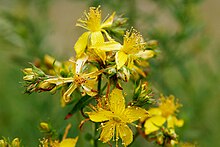St. Johnswort
| Hypericum perforatum | |
|---|---|
 |
|
| Scientific classification | |
| Kingdom: | Plantae |
| Clade: | Angiosperms |
| Clade: | Eudicots |
| Clade: | Rosids |
| Order: | Malpighiales |
| Family: | Hypericaceae |
| Genus: | Hypericum |
| Species: | H. perforatum |
| Binomial name | |
|
Hypericum perforatum L. |
|
Hypericum perforatum, known as perforate St John's-wort,common Saint John's wort and St John's wort, is a flowering plant in the family Hypericaceae. The common name "St John's wort" may be used to refer to any species of the genus Hypericum. Therefore, Hypericum perforatum is sometimes called "common St John's wort" or "perforate St John's wort" to differentiate it. It is a believed to be a medicinal herb with antidepressant activity, although high-quality clinical evidence for such effects is limited.
The primary pharmacologically active constituent of St John's wort, hyperforin, is an arachidonate 5-lipoxygenase inhibitor and COX-1 inhibitor in vitro.
Hypericum perforatum is native to parts of Europe and Asia but has spread to temperate regions worldwide as a cosmopolitan invasive weed.
The common name "St John's wort" comes from its traditional flowering and harvesting on St John's Day, 24 June. The genus name Hypericum is derived from the Greek words hyper (above) and eikon (picture), in reference to the tradition of hanging plants over religious icons in the home during St John's Day, to ward off evil.
Perforate St John's wort is a herbaceous perennial plant with extensive, creeping rhizomes. Its stems are erect, branched in the upper section, and can grow to 1 m high. It has opposite, stalkless, narrow, oblong leaves that are 1–2 cm long. The leaves are yellow-green in color, with scattered translucent dots of glandular tissue. The dots are conspicuous when held up to the light, giving the leaves the 'perforated' appearance to which the plant's Latin name refers. The flowers measure up to 2.5 cm across, have five petals, and are colored bright yellow with conspicuous black dots. The flowers appear in broad cymes at the ends of the upper branches, between late spring and early to mid summer. The sepals are pointed, with black glandular dots. There are many stamens, which are united at the base into three bundles. The pollen grains are ellipsoidal.
...
Wikipedia
